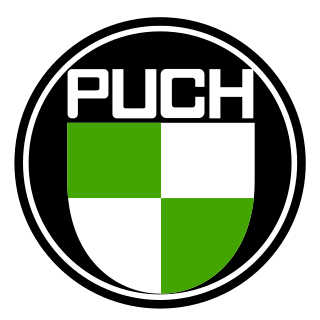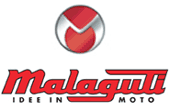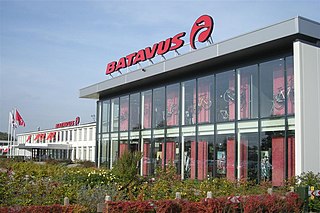
A moped is a type of small motorcycle, generally having a less stringent licensing requirement than full motorcycles or automobiles. The term used to mean a similar vehicle except with both bicycle pedals and a motorcycle engine. Mopeds typically travel only a bit faster than bicycles on public roads. Mopeds are distinguished from scooters in that the latter tend to be more powerful and subject to more regulation.

Pashley Cycles is a British bicycle, tricycle and workbike manufacturer based in Stratford-upon-Avon in Warwickshire, England. The company was started in 1926 and still manufactures bikes in the UK.

Puch is a manufacturing company located in Graz, Austria. The company was founded in 1899 by the industrialist Johann Puch and produced automobiles, bicycles, mopeds, and motorcycles. It was a subsidiary of the large Steyr-Daimler-Puch conglomerate.

ZF Sachs AG, also known as Fichtel & Sachs, was founded in Schweinfurt in 1895 and was a well-known German family business. At its last point as an independent company, the company name was Fichtel & Sachs AG.

Motobécane was a French manufacturer of bicycles, mopeds, motorcycles, and other small vehicles, established in 1923. "Motobécane" is a compound of "moto", short for motorcycle; "bécane" is slang for "bike."

Malaguti is an Italian bicycle, scooter and motorcycle company based in San Lazzaro di Savena, founded by Antonino Malaguti in 1930. Producing bicycles until 1958, they then entered the motorcycle market. Noted for their use of small engines in their bikes. In October 2011, Malaguti laid off its remaining employees in Bologna, Italy as the company eventually folded. In 2018 the company was purchased by the Austrian firm KSR Group GmbH.

A motorized bicycle is a bicycle with an attached motor or engine and transmission used either to power the vehicle unassisted, or to assist with pedalling. Since it sometimes retains both pedals and a discrete connected drive for rider-powered propulsion, the motorized bicycle is in technical terms a true bicycle, albeit a power-assisted one. Typically they are incapable of speeds above 52km/h.

An electric bicycle is a motorized bicycle with an integrated electric motor used to assist propulsion. Many kinds of e-bikes are available worldwide, but they generally fall into two broad categories: bikes that assist the rider's pedal-power and bikes that add a throttle, integrating moped-style functionality. Both retain the ability to be pedaled by the rider and are therefore not electric motorcycles.
Many countries have enacted electric vehicle laws to regulate the use of electric bicycles. Countries such as the United States and Canada have federal regulations governing the safety requirements and standards of manufacture. Other countries like the signatories of the European Union have agreed to wider-ranging legislation covering use and safety.
Pope Manufacturing Company was founded by Albert Augustus Pope around 1876 in Boston, Massachusetts, US and incorporated in Hartford, Connecticut in 1877. Manufacturing of bicycles began in 1878 in Hartford at the Weed Sewing Machine Company factory. Pope manufactured bicycles, motorcycles, and automobiles. From 1905 to 1913, Pope gradually consolidated manufacturing to the Westfield Mass plant. The main offices remained in Hartford. It ceased automobile production in 1915 and ceased motorcycle production in 1918. The company subsequently underwent a variety of changes in form, name and product lines through the intervening years. To this day, bicycles continue to be sold under the Columbia brand.
Norman Cycles was a British bicycle, autocycle, moped, and motorcycle manufacturer in Ashford, Kent, England.
Mego (ΜΕΓΚΟ) was a Greek light vehicle manufacturer, based in Trikala. Its first products, launched in 1947, were utility tricycles. In 1951, it began manufacturing motorized utility tricycles with 50–100cc engines and an unconventional design in which the solo wheel was located at the rear.

Sachs Bikes International Company Limited is a German-based motorcycle manufacturer, founded in 1886 in Schweinfurt as Schweinfurter Präzisions-Kugellagerwerke Fichtel & Sachs, formerly known as Fichtel & Sachs, Mannesmann Sachs and later just Sachs.

Tempo was a Norwegian motorcycle and moped brand. Jonas Øglænd made the rolling chassis and most of the parts thereof, and Fichtel & Sachs AG made the engines for the majority of the models. After 1972 the company made mopeds only.

Batavus BV is a Dutch bicycle manufacturer, owned by the Accell Group European Cycle conglomerate. Batavus Intercycle Corporation was the leading manufacturer of bicycles and mopeds in the Netherlands during the 1970s. During its most productive years, the company’s 350,000 sq ft (33,000 m2). Heerenveen plant employed 700 to produce 70,000 Batavus mopeds and 250,000 bicycles a year. During this time, Batavus was exporting 55 percent of its production with the remainder going to the Netherlands, which had more than two million mopeds in 1977.

Bianchi motorcycles were made from 1897 to 1967 by F.I.V. Edoardo Bianchi S.p.A., a company which today is a major Italian bicycle manufacturer, and who also produced automobiles from 1900 to 1939. Edoardo Bianchi started his bicycle manufacturing business in a small shop on Milan's Via Nirone in 1885. Bianchi was a prominent name in the motorcycle racing world from 1925 to 1930.

Hercules was a brand of bicycle and motorcycle manufactured in Germany.

Rieju is a manufacturer of mopeds and motorcycles from Spain. It is based in Figueres. They specialize in small displacement motorcycles, using Minarelli engines. Their products are available in almost all European countries.
The Aberdale Cycle Company was founded in 1919. The company concentrated on high volume, popular bicycles. In the mid-1930s the company moved to a modern factory in London and also acquired the Bown Manufacturing Company. Bown brought experience of building motorcycles and with rising demand for motorised transport after 1945, the company began producing mopeds and light-weight motorcycles at their London plant and in Wales. In 1958 Aberdale were acquired by the British Cycle Corporation while the Aberdale management went on to found Trusty Manufacturing Co Ltd.

Rixe is a German bicycle, moped, and small motorcycle factory in Brake of Bielefeld.




















